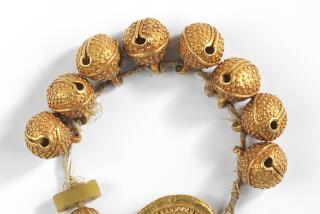King Tut exhibition comes to L.A., but it’s not the same as you might remember

Mayor Eric Garcetti and archaeologist Dr. Zahi Hawass usher in the new King Tut exhibition at the California Science Center, which celebrates the 100-year anniversary of the discovery of his tomb.
- Share via
The golden relics of Tut, evoking the life, mysterious death and storied afterlife of the 19-year-old Egyptian King Tutankhamun, is, for many of us, embedded in our childhood memories — along with those long, long entrance lines.
A touring King Tut exhibition in the 1960s was followed by the blockbuster tour of the ’70s — the one that broke records at the Los Angeles County Museum of Art, drawing more than 1 million visitors and to this day the museum’s most highly attended show. Two exhibitions have roamed the globe in this century, including “Tutankhamun and the Golden Age of the Pharaohs,” which showed at LACMA in 2005, and another one in 2008.
For the record:
1:55 p.m. March 21, 2018An earlier version of this article reported that a “coffinette” containing King Tut’s mummified liver will be on view in new exhibit. The coffinette will be on view, but the mummified liver will not be inside.
Now he’s back: “King Tut: Treasures of the Golden Pharaoh,” timed to the upcoming 100th anniversary of the discovery of Tut’s tomb, opens at the California Science Center on Saturday.
British archaeologist Howard Carter unearthed the 3,300-year-old bedrock tomb on Nov. 4, 1922, revealing a wealth of ancient Egyptian secrets — and schoolchildren’s field trips were forever altered.
But “Treasures of the Golden Pharaoh,” for better or for worse, is not the King Tut exhibit Mrs. Felsen dragged you to in eighth grade. Organized by the Egyptian Ministry of Antiquities and the management company IMG, the new exhibition has about triple the number of objects that have previously toured — many leaving Egypt for the first time — along with advanced display technology and new science about King Tut’s life, health, death and lineage.
But along with the additions, Tut completists will note some absences in the exhibit inventory. Here’s what you will find when Tut rolls into town.
More is more
A core of about 50 objects have consistently traveled with King Tut exhibitions in the past. You remember, the small, gold “coffinette” that contained King Tut’s mummified liver, the gold shrine etched with images of King Tut and his wife, King Tut’s carved wooden bust.
Many of the favorites are back, like the coffinette. The new exhibition has 166 total objects, the largest number of King Tut items ever displayed publicly outside Egypt. About 40% of the works haven’t left the Museum of Egyptian Antiquities before.
Some items, however, are not returning. Among them: the gold, crown-like diadem from the mummy’s head, as well as a wooden King Tut mannequin.
In curating new material for the exhibit, organizers said they aimed for intimate objects like the gold sandals on the mummy’s feet when it was discovered, and a pair of worn linen gloves he may have used in real life, circa 1336 BC. There’s also a ceremonial wooden bed with lion feet, created for King Tut’s body to rest during the afterlife, plus jewelry galore, including gold bands embedded with semiprecious stones and wrapped around the mummy’s exterior.
A limited-time offer?
Whether or not it sounds like a marketing ploy, organizers of “Treasures of the Golden Pharaoh” said this may be the last time the Tutankhamun collection travels as a whole outside Egypt. The exhibition will appear in 10 cities internationally over seven years, then the objects will go to the still-under-construction Grand Egyptian Museum in Cairo, where they will remain permanently.
Immersive galleries
“Immersive” may have been the arts buzzword of 2016, but it’s still going strong today. “Treasures of the Golden Pharaoh” will feature an “immersive environment,” organizers said. That begins with a four-minute introductory film on a 180-degree screen meant to transport people to the Valley of the Kings, where Tut’s tomb was discovered.
During the nine-gallery exhibit that follows, guests will pass through six gates of the underworld as they travel with King Tut on his quest for immortality. Along the way, they will encounter good luck amulets, weapons meant to fight off demons, alabaster containers of oils that the ancient Egyptians believed enabled him to see and hear in the underworld, and figurines of gods meant to guide and protect him.
3-D views
New 3-D scans of objects are animated on video screens on top of display cases, so viewers can zoom in and spin the objects onscreen for an interactive experience.
“There’s a lot more technology in this exhibition when it comes to being able to help tell the story,” says John Norman, IMG’s managing director of exhibitions, who also organized the 2005 and 2008 Tut exhibitions. “With these videos, you really get to see these objects in a way you’ve never seen them before.”
Scientific analysis
The last galleries in the show focus on the discovery of the tomb itself and the history of Egyptian archaeology along with new scientific analysis of the mummy.
Tut was only about 9 when he became king and 19 when he died, but his exact cause of death has long been a mystery. It still is.
But thanks to technology and new analysis over the last decade, researchers have a better understanding of the circumstances surrounding his death.
A video table in the exhibition shows CT scan data of King Tut’s mummy. The scan is from 2005, but advances in technology have made it possible to glean more information about it. King Tut had a club foot and an impacted wisdom tooth. New DNA testing shows that King Tut also suffered malaria.
The child king had a badly broken left leg above the knee that pierced his skin. That likely resulted in an infection that caused death.
A new family tree in the exhibit highlights who’s who in King Tut’s lineage.
“The one thing we absolutely didn’t want to do,” Norman said, “was duplicate what had been done before.”
♦ ♦ ♦ ♦ ♦ ♦ ♦ ♦ ♦ ♦
‘King Tut: Treasures of the Golden Pharaoh’
Where: California Science Center, 700 Exposition Park Drive, Los Angeles.
When: March 24-Jan. 6
Admission: $19.50-$30
Info: (323) 724-3623, californiasciencecenter.org

“Treasures of the Golden Pharaoh” exhibit lands at California Science Center
Follow me on Twitter: @debvankin
More to Read
The biggest entertainment stories
Get our big stories about Hollywood, film, television, music, arts, culture and more right in your inbox as soon as they publish.
You may occasionally receive promotional content from the Los Angeles Times.











